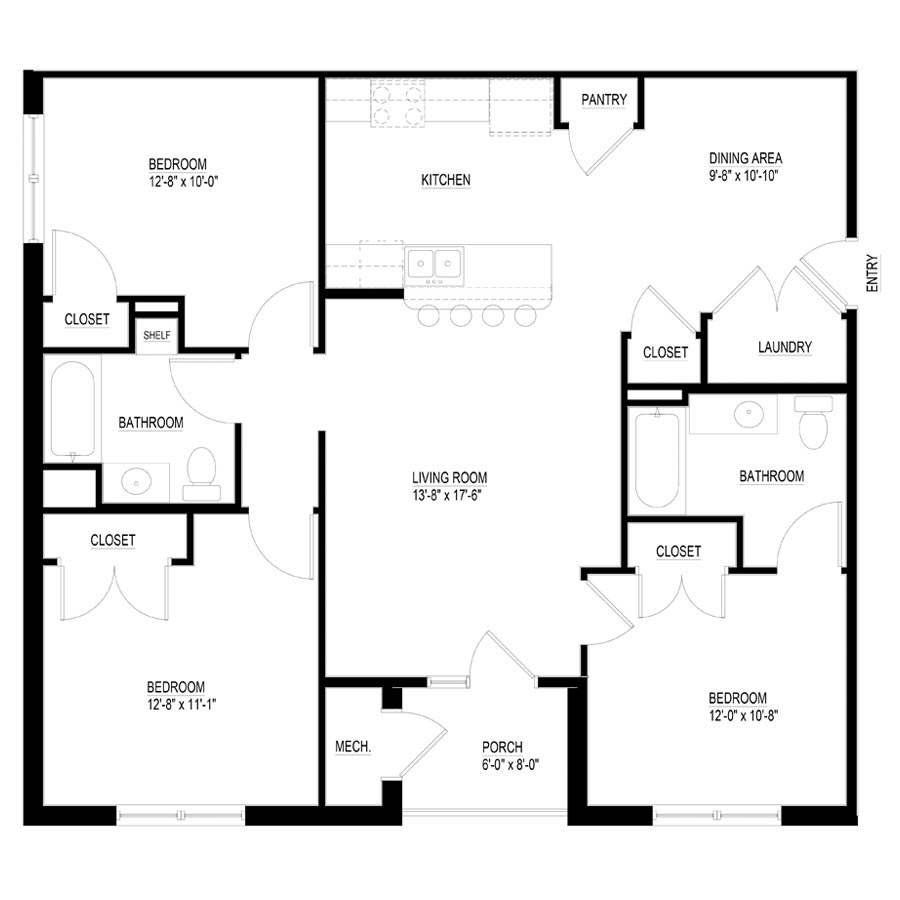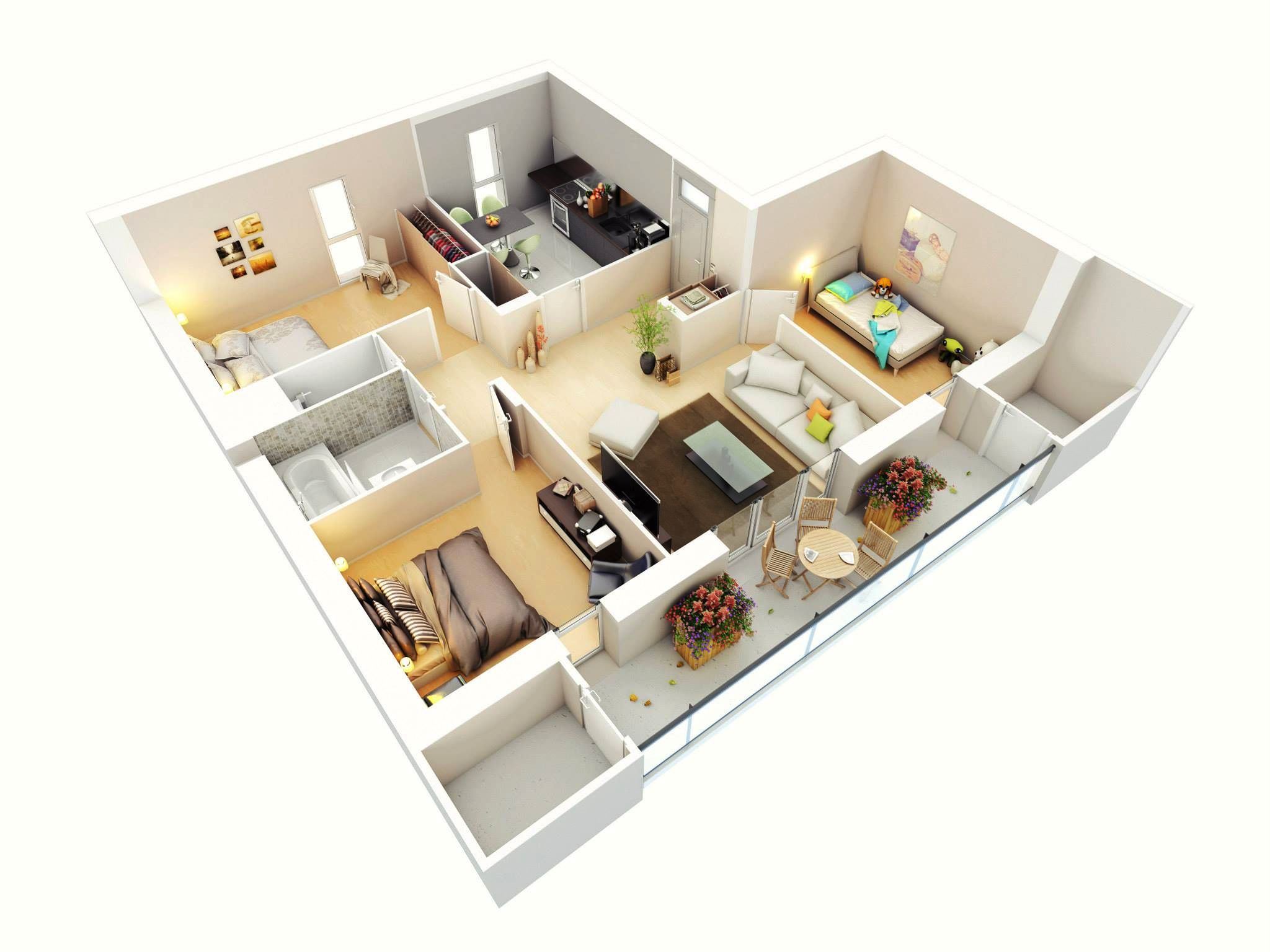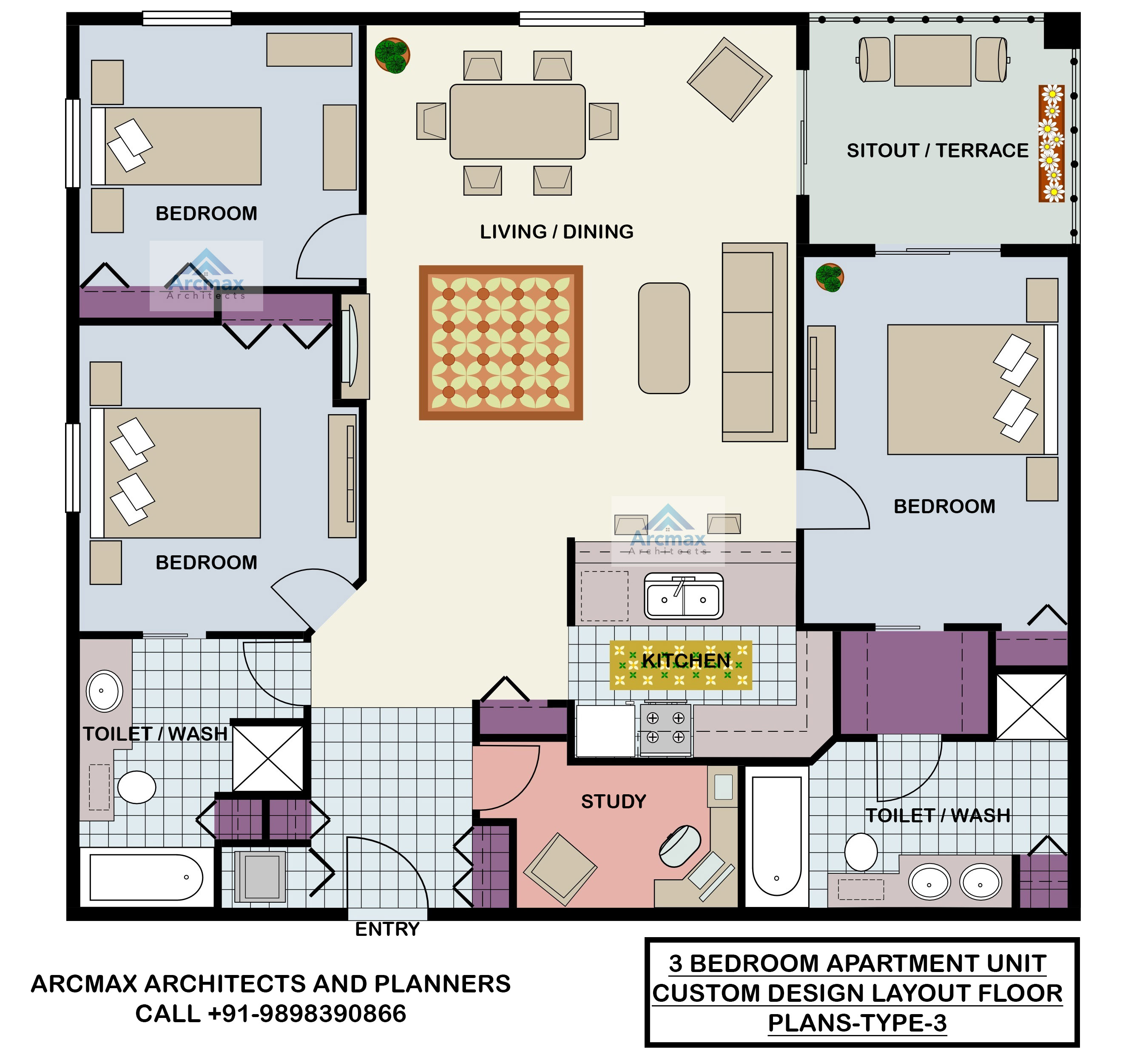Understanding 3 Bedroom Floor Plan Design Basics

Designing a 3-bedroom floor plan is a journey of creating a functional and aesthetically pleasing space that reflects your lifestyle and needs. This process involves considering various factors that contribute to a harmonious and comfortable living environment.
Key Considerations for Designing a Functional and Aesthetically Pleasing 3-Bedroom Floor Plan
A successful 3-bedroom floor plan considers the interplay between functionality and aesthetics. It’s about creating a space that not only serves its purpose but also inspires and delights. Here are some key considerations:
- Functionality: The floor plan should facilitate a smooth flow of movement within the home, ensuring easy access to all areas and minimizing congestion. This includes strategic placement of doors, hallways, and staircases.
- Aesthetics: The design should incorporate elements that create a visually appealing and inviting atmosphere. This can be achieved through the use of color, texture, lighting, and furniture placement.
- Space Utilization: Maximizing the use of available space is crucial. This involves creating a layout that optimizes storage solutions and minimizes wasted areas.
- Natural Light: Maximizing natural light is essential for creating a bright and airy environment. This can be achieved through the strategic placement of windows and skylights.
- Privacy: Each bedroom should offer a sense of privacy and tranquility. This can be achieved through the use of partitions, room dividers, or strategic placement of furniture.
Space Flow, Traffic Patterns, and Natural Light
The way people move through a space, known as traffic patterns, is essential to consider when designing a floor plan. A well-designed layout minimizes congestion and creates a sense of ease. Here’s how these elements contribute to a functional and aesthetically pleasing 3-bedroom floor plan:
- Space Flow: Creating a smooth flow of movement throughout the home is essential for a comfortable living experience. This involves strategically placing doorways, hallways, and staircases to minimize bottlenecks and maximize efficiency.
- Traffic Patterns: Consider the typical movement patterns within the home, such as the flow from the entryway to the living area, kitchen, and bedrooms. Optimize the layout to minimize congestion and create a seamless flow of movement.
- Natural Light: Maximizing natural light is essential for creating a bright and inviting atmosphere. Strategic placement of windows and skylights can illuminate the interior, enhancing the sense of spaciousness and well-being.
Common Layouts for 3-Bedroom Homes
There are various common layouts for 3-bedroom homes, each offering unique advantages and disadvantages. Understanding these layouts can help you choose the best option for your needs and preferences:
- Open-Concept: This layout features a large, open space that combines the living room, dining room, and kitchen. It promotes a sense of spaciousness and allows for easy interaction between family members.
- Traditional: This layout features separate rooms for each function, such as a living room, dining room, and kitchen. It offers a more formal and traditional feel and provides greater privacy for each space.
- Split-Level: This layout features two levels, typically with the living area and bedrooms on one level and the kitchen and dining area on another. It provides a sense of separation between different areas of the home and can be an effective way to maximize space.
Examples of Successful 3-Bedroom Floor Plan Designs
Here are examples of successful 3-bedroom floor plan designs, highlighting their unique features and strengths:
- The L-Shaped Kitchen: This design features a kitchen that is shaped like an “L,” with the sink and stove located on opposite sides. This layout is popular because it allows for easy movement and provides ample counter space.
- The Master Suite: This design includes a master bedroom with a private bathroom and walk-in closet. It provides a luxurious and private retreat within the home.
- The Open Floor Plan: This design features a large, open space that combines the living room, dining room, and kitchen. It promotes a sense of spaciousness and allows for easy interaction between family members.
Designing for Different Lifestyles and Needs

3 bedroom floor plan design – A well-designed floor plan is a reflection of the people who inhabit it, their unique needs, and their aspirations. It’s not just about the arrangement of rooms but also about the flow of life, the spaces that nourish the soul, and the areas that encourage growth. Just as a painter uses different hues to capture the essence of a scene, a floor plan designer uses space to create a canvas for life’s diverse expressions.
Designing for a Young Family with Small Children
The home of a young family with small children is a symphony of laughter, playful exploration, and the constant hum of activity. A well-designed floor plan caters to these needs, providing ample space for play, fostering a sense of security, and making everyday life easier for parents. Here are some key considerations for designing a 3-bedroom floor plan for this demographic:
- Dedicated Play Area: A designated play area, whether in a separate room or a well-defined space within the living area, provides children with a safe and stimulating environment to explore their imagination. This area should be equipped with soft flooring, age-appropriate toys, and ample storage for toys and playthings.
- Easy Access to Bedrooms: Parents often need to check on their children during the night, so proximity to bedrooms is crucial. Consider placing the children’s bedrooms near the master bedroom for easy access and peace of mind.
- Plenty of Storage: Young families accumulate a lot of things, from toys and clothes to baby gear and supplies. Adequate storage solutions, including built-in cabinets, shelves, and drawers, help keep the home organized and clutter-free.
- Open Kitchen and Living Areas: An open floor plan allows parents to keep an eye on children while cooking or socializing in the living area. This creates a sense of connection and encourages family interaction.
- Safety First: Childproofing is essential. Consider using rounded corners on furniture, installing safety gates, and keeping potentially hazardous items out of reach.
Designing for a Couple with a Home Office
For couples who work from home, the home office is more than just a workspace; it’s a sanctuary of productivity and a haven for creative pursuits. A well-designed floor plan for this demographic prioritizes privacy, efficiency, and a sense of separation between work and personal life. Here are some design considerations:
- Dedicated Home Office Space: A separate room dedicated to the home office provides a dedicated workspace that minimizes distractions and promotes focus. This space should be well-lit, comfortable, and equipped with a desk, ergonomic chair, and ample storage for work-related items.
- Privacy and Separation: The home office should be located in a quiet area of the home, away from high-traffic zones. Consider using sound-absorbing materials or a door to create a sense of separation and minimize noise distractions.
- Natural Light: Natural light is essential for productivity and well-being. Position the home office near a window to maximize natural light exposure.
- Storage and Organization: An organized workspace is a productive workspace. Utilize built-in shelves, drawers, and filing cabinets to keep work-related items organized and accessible.
- Multi-Purpose Room: If space is limited, consider a multi-purpose room that serves as both a home office and a guest room. A Murphy bed or a convertible sofa can provide flexibility for both work and overnight guests.
Designing for a Multi-Generational Family
Multi-generational families bring together different life stages and needs under one roof. A well-designed floor plan for this demographic fosters both independence and connection, creating separate living spaces while maintaining shared areas for family gatherings. Here are some key considerations:
- Separate Living Spaces: Each generation should have its own private space to retreat to. This could include separate bedrooms, living areas, or even independent living suites.
- Shared Living Areas: Designate a central space, such as a kitchen or living room, for shared family gatherings and meals. This space should be large enough to accommodate everyone comfortably and should be easily accessible from all living areas.
- Accessibility: Consider the needs of older family members, such as easy access to bathrooms, kitchens, and other common areas.
- Privacy and Independence: While fostering connection, it’s important to provide each generation with a sense of privacy and independence. Consider separate entrances, private outdoor spaces, or dedicated areas for each family unit.
- Storage: Multi-generational families often have a lot of belongings. Plan for ample storage space throughout the home, including closets, built-in shelves, and storage rooms.
Comparing Design Considerations for a 3-Bedroom Apartment versus a 3-Bedroom House
While both a 3-bedroom apartment and a 3-bedroom house offer similar living space, there are distinct design considerations for each type of dwelling. Understanding these differences is crucial for maximizing the functionality and livability of the space.
| Feature | 3-Bedroom Apartment | 3-Bedroom House |
|---|---|---|
| Space | Typically smaller and more compact | Larger and more expansive |
| Layout | Often features an open floor plan to maximize space | Can accommodate more diverse layouts, including multiple levels |
| Storage | Limited built-in storage, requiring creative solutions | More flexibility for built-in storage and closets |
| Outdoor Space | Limited or no outdoor space, often a balcony or patio | Larger yards, gardens, or patios |
| Privacy | Less privacy due to shared walls and close proximity to neighbors | Greater privacy due to separate entrances and more private outdoor spaces |
Optimizing Space and Functionality: 3 Bedroom Floor Plan Design

A well-designed 3-bedroom floor plan is a canvas for creating a harmonious and functional living space. Just like a master artist carefully considers every stroke, we must consider how each element in our home contributes to its overall beauty and utility. This involves optimizing space, maximizing functionality, and embracing the potential of flexibility.
Maximizing Space with Smart Storage Solutions
Maximizing space in a 3-bedroom floor plan requires a strategic approach to storage. Think of storage solutions as an extension of your space, allowing you to declutter and create a sense of spaciousness.
Here are some smart storage solutions:
- Built-in Cabinets and Shelving: These are ideal for maximizing wall space and creating a streamlined look. They can be customized to fit your specific needs, whether it’s a pantry for the kitchen, a closet organizer for the bedroom, or a bookshelf for the living room.
- Under-Bed Storage: This is a great way to utilize often-wasted space. Consider using drawers, lift-up platforms, or even storage boxes to store items that are not frequently used.
- Multifunctional Furniture: Choose furniture that serves multiple purposes, such as a sofa bed that can transform into a guest bed or a coffee table with built-in storage.
- Vertical Storage: Vertical storage solutions, like wall-mounted shelves and hanging organizers, can help to maximize vertical space and keep items off the floor.
Creating Flexible Spaces for Different Needs
Flexibility is key in a 3-bedroom floor plan, allowing you to adapt your home to changing needs and lifestyles. One approach is to create a den that can double as a guest room.
- Multifunctional Den: A den can serve as a home office, a playroom for children, a reading nook, or a guest room. By incorporating a comfortable sofa bed, a desk, and storage solutions, you can create a space that easily adapts to different uses.
- Open Floor Plan: An open floor plan can create a sense of spaciousness and flexibility. It allows for seamless transitions between different areas of the home, such as the kitchen, dining room, and living room.
Organizing Dedicated Zones for Different Activities
A well-organized 3-bedroom floor plan should have dedicated zones for different activities, such as cooking, dining, and relaxing.
- Kitchen Zone: The kitchen should be a functional and inviting space for preparing meals. Consider a well-designed layout with ample counter space, storage, and appliances.
- Dining Zone: The dining zone should be a comfortable and welcoming space for enjoying meals with family and friends. Choose a dining table and chairs that suit your needs and style.
- Relaxation Zone: The relaxation zone should be a tranquil space for unwinding and de-stressing. This could be a living room with comfortable seating, a reading nook, or a meditation space.
Designing for Sustainability, 3 bedroom floor plan design
Sustainable design practices can create a more eco-friendly and energy-efficient home.
- Natural Ventilation: Incorporating windows and doors that allow for natural ventilation can help to reduce energy consumption and improve indoor air quality.
- Energy-Efficient Appliances: Choose appliances that are Energy Star certified, as these are designed to be more energy-efficient and can save you money on your utility bills.
- Water Conservation: Install low-flow showerheads and toilets to conserve water.
The allure of a spacious three-bedroom floor plan is often overshadowed by the banal details, like bathroom rugs. But even these seemingly insignificant elements can reflect the homeowner’s taste and attention to detail. A well-chosen bathroom rug, like those discussed in this article , can elevate the overall aesthetic of a room, just as a thoughtfully designed floor plan can maximize functionality and flow within a home.
While a 3 bedroom floor plan design can offer flexibility and space, it’s crucial to remember that the details matter. A well-designed bathroom, for instance, can elevate the entire living experience. Consider incorporating the luxurious touch of modern gold bathroom taps to create a sophisticated and inviting ambiance, reflecting the homeowner’s discerning taste.
These small but impactful choices can transform a 3 bedroom floor plan from functional to truly luxurious.